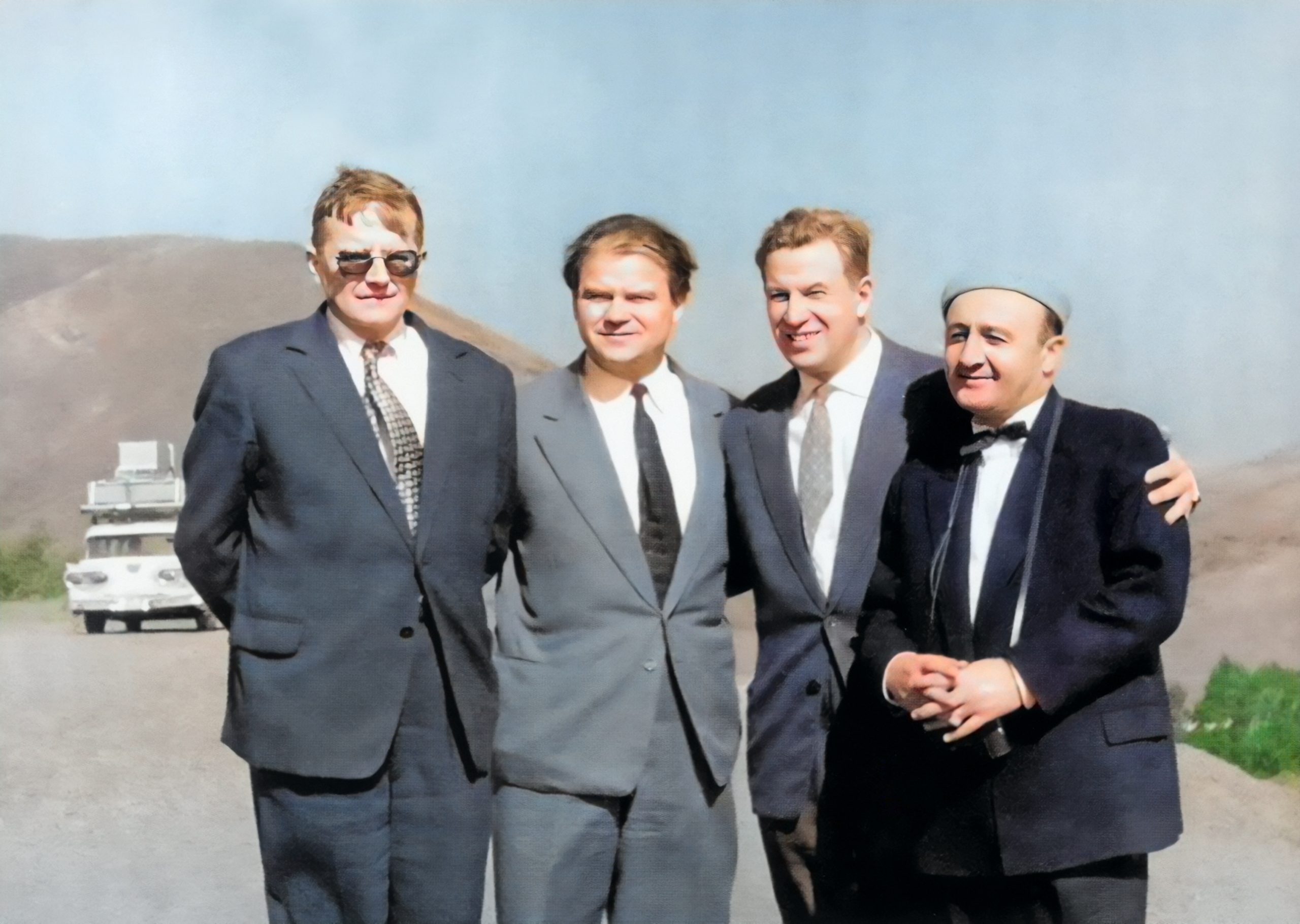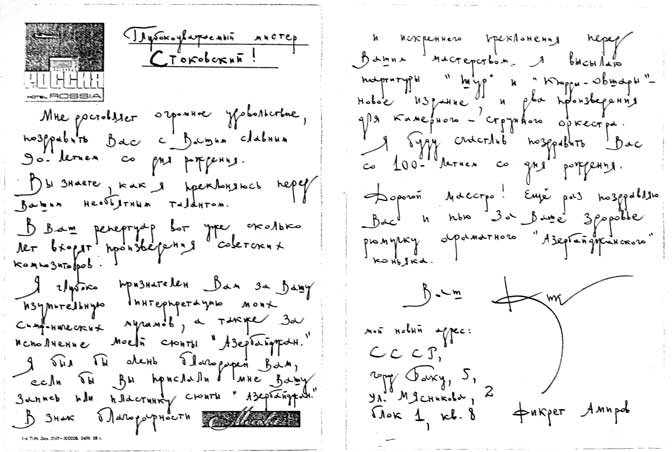FIKRET AMIROV: Diversity of Sounds within the Orchestra

Announcing: The Hajibeyli International Composition Competition
February 28, 2021 The symphony is one of the most widely performed genres by orchestras worldwide. Initially emerging as an overture to Italian operas, the genre has undergone extended historic evolution under the pen of notable composers. In the 18th century, it came to prominence with the development of the well-known Manheim orchestra and works of Johann Stamitz (1717 – 1757) and culminated in symphonies of the Vienesse Classical School, Joseph Haydn (1732-1809), Wolfgang Amadeus (1756-1791) Mozart, and Ludwig van Beethoven (1770-1827). Beethoven’s 9th symphony, a monumental four-movement oeuvre featuring vocal soloists and a chorus based on F. Schiller’s “Ode to Joy” poem, expanded the limits of the genre, reshaped the structure, enriched the harmonic language, and freed symphony of its established canons. F. Schubert, A. Bruckner, J. Brahms, H. Berlioz, G. Mahler followed his path. A. Dvořák and P. I. Tchaikovsky began incorporating national idioms and folk music into their symphonies. The tendency to nationalize art and music began to thrive among various cultures, impacting the emergence of national music schools.
The symphony is one of the most widely performed genres by orchestras worldwide. Initially emerging as an overture to Italian operas, the genre has undergone extended historic evolution under the pen of notable composers. In the 18th century, it came to prominence with the development of the well-known Manheim orchestra and works of Johann Stamitz (1717 – 1757) and culminated in symphonies of the Vienesse Classical School, Joseph Haydn (1732-1809), Wolfgang Amadeus (1756-1791) Mozart, and Ludwig van Beethoven (1770-1827). Beethoven’s 9th symphony, a monumental four-movement oeuvre featuring vocal soloists and a chorus based on F. Schiller’s “Ode to Joy” poem, expanded the limits of the genre, reshaped the structure, enriched the harmonic language, and freed symphony of its established canons. F. Schubert, A. Bruckner, J. Brahms, H. Berlioz, G. Mahler followed his path. A. Dvořák and P. I. Tchaikovsky began incorporating national idioms and folk music into their symphonies. The tendency to nationalize art and music began to thrive among various cultures, impacting the emergence of national music schools.

The birth of the national classical music school, including the development of Azerbaijan’s national symphony, is closely associated with the name of Uzeyir Hajibeyli (1885-1945). Initiated by U. Hajibeyli in 1920, the symphony orchestra of Azerbaijan quickly became one of the leading orchestras in the former Soviet Union. Along with Hajibeyli, conductors Rene Baton of France, Otto Klemperer of Germany, Fritz Stiedry of Austria, and Nikolai Golovanov of Russia played a significant role in expanding the repertoire and size of the orchestra. Under Hajibeyli’s guidance, the national music of Azerbaijan and the national orchestra made a remarkable advancement. Hajibeyli’s recognition of the abundance and possibilities of national music, especially of the complex art of Mugham with its modal language, based on ancient modes/scales and its integration with the established Western forms, gave unprecedented artistic growth into the development of Azerbaijani classical music, including symphony. In this sense, his monograph “Fundamentals of Azerbaijani Folk Music” was priceless.

Fikret Amirov and His Favorite Tar
Composers Soltan Hajibeyli, Jevdet Hajiyev, Gara Garayev, Vasif Adigozalov, Agshin Alizadeh, and many others contributed to the development of the symphony genre in Azerbaijan. However, the manifestation of Hajibeyli ideals, reflection of his vision and hope for the future found its complete expression in Symphonic Mughams of Fikret Amirov, one of the leading composers of Azerbaijan whose centennial is celebrated today, November 22, 2022.
Amirov’s father, Mashadi Jamil Amirov (1875 — 1928), was an acclaimed musician and connoisseur of Azerbaijani folk music. He played various musical instruments, including tar, a long-necked, waisted lute family instrument, a key element for practicing and executing the Azerbaijani modal systems, and Mugham.

Mashed Jamil Amirov, father of Fikret Amirov
Determined to disseminate what he had learned to others, Amirov senior established a course, held musical evenings, and ultimately opened a music school where young talents were introduced to the subtleties of Azerbaijani folk music. The environment impacted young Fikret Amirov and defined the essence and genesis of his future compositional methods. Like Hungarian composers Bela Bartók and Zoltán Kodály, Amirov also began exploiting the techniques he learned from authentic folk songs he collected through various regions to inform his music. Furthermore, guided by Hajibeyli and encouraged by the well-known tenor Bulbul, Fikret Amirov developed a groundbreaking Symphonic Mugham genre, a single-movement symphonic suite based on Azerbaijani traditional music.
That entire innovative approach culminated in the perfect amalgamation of the purely Eastern art of Mugham with the solely Western technique of the Symphonic genre. Three Symphonic Mughams: “Shur,” “Kurd Ovshari” (both in 1948), and “Gulustan Bayati Shiraz” (1971), were the results of the revolutionary attempt by the composers that enriched the historic genre through the diversity of sounds within the orchestra.
According to the composer:
“As I listened to and deeply studied Mugham, it became clear that the dynamics, intensity, and modal developments of Mugham are compatible with the principles of the symphony. Translation of it
into the language of a modern symphonic orchestra will not weaken or undermine but, on the contrary, will intensify and reinforce the Mugham. The rigid impregnable canons of Mugham are wise and flexible enough in the hands of those who mastered them. It also became clear that, despite the antiquity of its origin, Mugham is not at all archaic: it naturally fits a symphonic score, thereby confirming its unlimited possibilities.”

Dmitri Shostakovich, Tikhon Khrennikov, Boris Yarustovsky, and Fikret Amirov. California. October 1959.

Fikret Amirov
The structure of the Mugam genre is called Dastgah. The monumental, uninterrupted Mugham develops gradually, alternating between improvisational and rhythmical sections called Tesnif (song) and Reng (instrumental dance). The entire composition is unified under the common modal/scale system and aesthetics, defined in the title of the Mugham, which also establishes the piece’s character. Inherent to Mugham, contrast is also the main driving element of the symphonic genre which opens doors for colorful melodic orchestration. The contrast and variance, orchestral and melodic, became the essence of all three Symphonic Mughams of Amirov.
In the symphonic mugham “Shur” and “Kurd Ovshari,” Amirov adheres to the original structures of the respective Dastgahs. These are monumental one-movement and purely instrumental compositions. The “Gulustani Bayati Shiraz” was inspired by and dedicated to Medieval Persian poets of Sadi Shirazi and Hafiz, originally from Shiraz. The composer added a solo vocal part (mezzo-soprano) into the symphonic work and enriched it with elements from other folk mediums, including the music of minstrels called “ashig.” Its structure is closest to the sonata-allegro form of the traditional classical symphony.
 Symphonic Mughams of Amirov received international recognition. Under the baton of such outstanding conductors as G. Abendroth (1954), Leopold Stokowski (1959), Charles Munsch (1959), and others, they were performed in the USA, England, France, Germany, Belgium, Romania, the Czech Republic, and many other countries worldwide. Leopold Stokowski conducted Fikret Amirov’s symphonic Mugham “Kurd Ovshari” with the Houston Symphony on March 16, 1959. He also recorded it two days later on Everest SDBR 3032 (33 RPM) along with the A. Scriabin’s Poem of Ecstasy. On March 3-6, 1960, Stokowski conducted the New York Philharmonic performing yet another symphonic work of Amirov, Azerbaijan Suite of 1950. This performance was also recorded and released on Guild Historical GHCD 2415. Other notable orchestral works of Fikret Amirov are the suite “Azerbaijan” (1950), “Azerbaijan Capriccio” (1961), and “Symphonic Dances” (1963), imbued with national melodies as well. Symphonic Mughams of Amirov inspired many other Azerbaijani composers, such as Niyazi, S. Aleskerov, and T. Bakikhanov.
Symphonic Mughams of Amirov received international recognition. Under the baton of such outstanding conductors as G. Abendroth (1954), Leopold Stokowski (1959), Charles Munsch (1959), and others, they were performed in the USA, England, France, Germany, Belgium, Romania, the Czech Republic, and many other countries worldwide. Leopold Stokowski conducted Fikret Amirov’s symphonic Mugham “Kurd Ovshari” with the Houston Symphony on March 16, 1959. He also recorded it two days later on Everest SDBR 3032 (33 RPM) along with the A. Scriabin’s Poem of Ecstasy. On March 3-6, 1960, Stokowski conducted the New York Philharmonic performing yet another symphonic work of Amirov, Azerbaijan Suite of 1950. This performance was also recorded and released on Guild Historical GHCD 2415. Other notable orchestral works of Fikret Amirov are the suite “Azerbaijan” (1950), “Azerbaijan Capriccio” (1961), and “Symphonic Dances” (1963), imbued with national melodies as well. Symphonic Mughams of Amirov inspired many other Azerbaijani composers, such as Niyazi, S. Aleskerov, and T. Bakikhanov.

Letter to L. Stokowski

